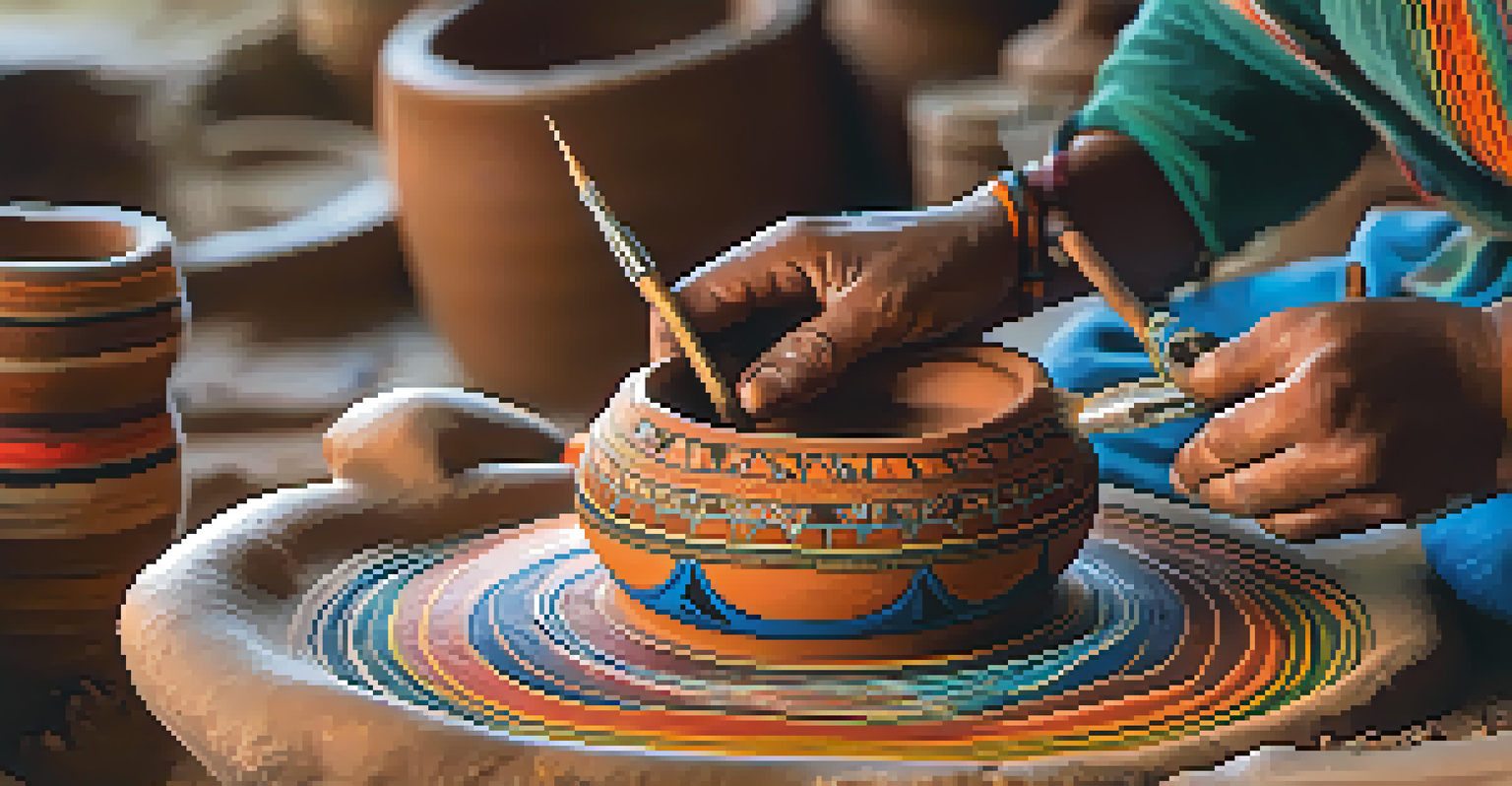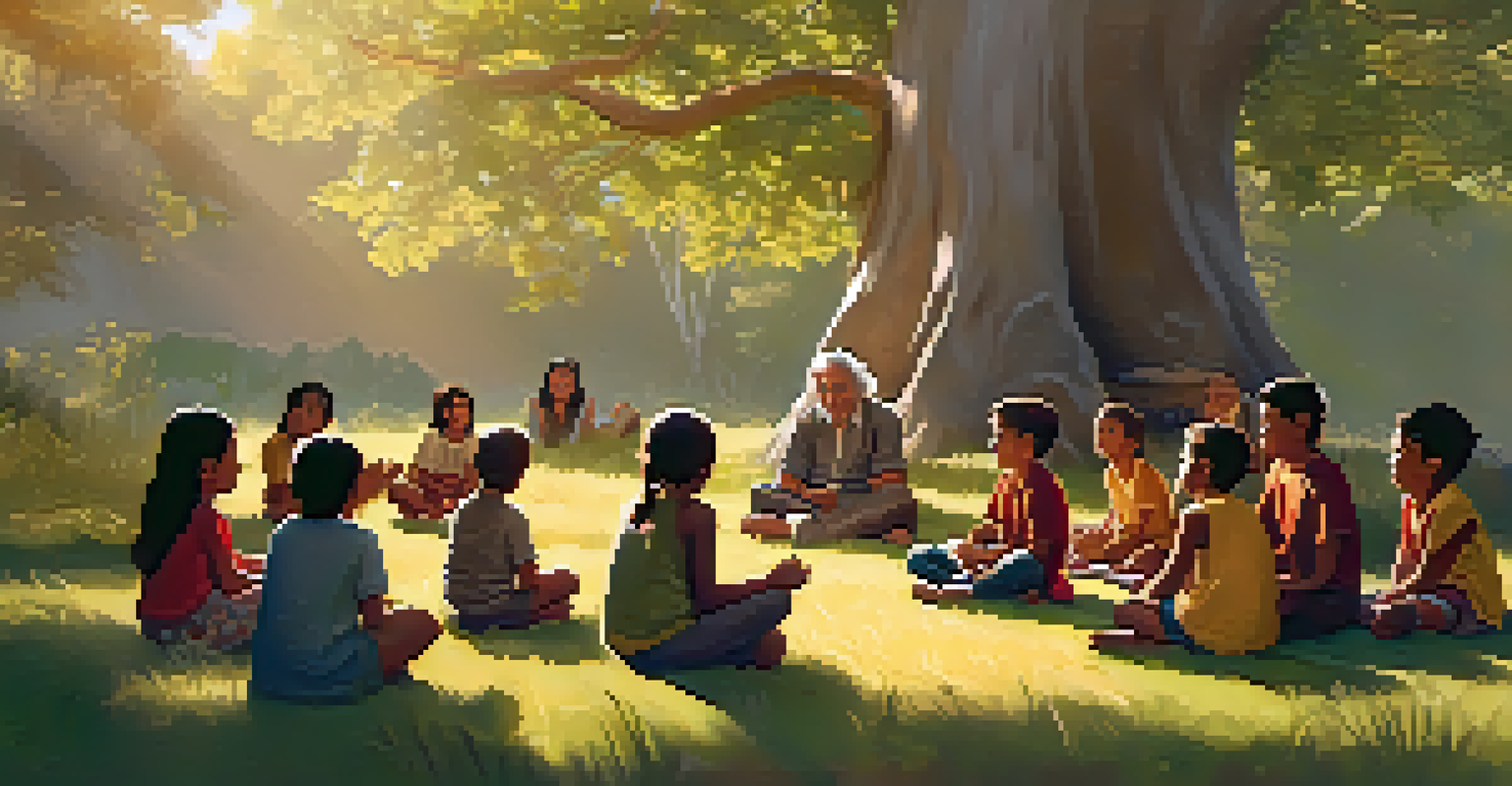Exploring the Role of Art in Indigenous Cultural Rituals

Understanding Indigenous Cultural Rituals and Their Significance
Indigenous cultural rituals are deeply rooted in tradition and spirituality, often passed down through generations. These rituals serve various purposes, from celebrating life events to honoring ancestors and connecting with nature. They are vital for the identity and cohesion of Indigenous communities, offering a sense of belonging and continuity.
Art is not what you see, but what you make others see.
Art plays a crucial role in these rituals, acting as a medium for expression and communication. It encompasses various forms, including painting, music, dance, and storytelling, each imbued with cultural meaning. By engaging in these artistic practices, Indigenous peoples not only preserve their heritage but also adapt it to contemporary life.
The integration of art in rituals allows communities to convey their values and beliefs in a vivid and engaging manner. It transforms abstract concepts into tangible experiences, fostering a deeper understanding of their cultural narratives. Thus, art becomes a bridge linking the past with the present, enriching the ritual experience.
Art as a Medium of Storytelling in Rituals
Storytelling is an essential aspect of Indigenous cultures, and art is often used to narrate these tales. Through visual art, performers, and musicians, stories come alive, allowing the community to connect with their history and mythology. These stories not only entertain but also impart wisdom and moral lessons important for cultural continuity.

For instance, many Indigenous artworks depict stories of creation, ancestors, and nature, encapsulating the worldview of the community. The use of symbols and motifs in these artworks carries deep meanings that resonate with the community’s beliefs, providing layers of understanding for both participants and observers. This storytelling through art fosters a shared identity among community members.
Art as Cultural Expression
Indigenous art serves as a vital medium for storytelling and preserving cultural heritage, connecting communities to their identity and history.
Moreover, the act of creating and sharing these stories during rituals reinforces communal ties. It encourages participation, invites dialogue, and nurtures a sense of pride in one's heritage. In this way, art becomes a powerful vehicle for preserving and passing on cultural knowledge.
The Role of Music and Dance in Indigenous Rituals
Music and dance are integral components of many Indigenous rituals, infusing them with energy and emotion. These artistic expressions often accompany ceremonies, enhancing their significance and creating an immersive experience for participants. Through rhythm and movement, communities celebrate their heritage and express their spiritual beliefs.
The more that you read, the more things you will know. The more that you learn, the more places you'll go.
Each dance and song carries its unique story, often reflecting cultural narratives, seasonal changes, or historical events. The choreography and melodies are typically taught through oral traditions, ensuring that the knowledge is preserved and passed down. This dynamic aspect of art allows for adaptability, enabling Indigenous cultures to evolve while maintaining their essence.
Additionally, music and dance foster unity among participants, creating a shared sense of purpose. When community members come together to perform, they strengthen their bonds and reaffirm their collective identity. In essence, these art forms are not just entertainment; they are vital expressions of cultural resilience.
Visual Arts: Crafting Identity and Heritage
Visual arts, including pottery, weaving, and painting, are pivotal in expressing Indigenous identity and heritage. Each piece often tells a story or conveys cultural values, showcasing the skills and creativity of the artist. These artworks not only serve decorative purposes but also hold significant cultural and spiritual meanings within the community.
For example, traditional weaving practices often incorporate patterns and colors that symbolize important aspects of the culture, such as land, history, and spirituality. By engaging in these art forms, Indigenous peoples maintain a tangible connection to their ancestry and cultural narratives. This preservation is essential in a world where cultural appropriation and loss are prevalent.
Spiritual Significance of Art
Art in Indigenous rituals is deeply spiritual, facilitating communication with ancestors and enriching the cultural experience.
Furthermore, the visual arts play a role in educating outsiders about Indigenous cultures. Exhibitions and art shows provide platforms for artists to share their stories, fostering greater appreciation and understanding. As a result, visual arts become a medium for dialogue and cultural exchange, bridging gaps between Indigenous and non-Indigenous communities.
The Spiritual Connection Between Art and Rituals
For many Indigenous peoples, art is inherently spiritual, deeply intertwined with their beliefs and practices. Creating art is often viewed as a sacred act, where artists channel their spirituality into their work. This connection elevates the art form, allowing it to transcend mere aesthetics and become a vessel for cultural expression.
In rituals, art can facilitate communication with the spiritual world, serving as an offering or a means of connection to ancestors and deities. The act of creating or performing art during these ceremonies invokes a sense of reverence, transforming the experience into something profoundly meaningful. This spiritual dimension enriches the ritual, deepening the participants' engagement.
Moreover, the spiritual aspect of art fosters a sense of responsibility among artists to honor their culture. By creating art that reflects their heritage, they contribute to the preservation of their identity and values. This commitment ensures that the spirituality embedded in their art continues to resonate within the community for generations to come.
Challenges Facing Indigenous Art in Modern Society
Despite the significance of art in Indigenous cultural rituals, various challenges threaten its preservation and practice today. Globalization, cultural appropriation, and economic pressures can dilute traditional practices, leading to a loss of authenticity. Many Indigenous artists struggle to find platforms that respect and honor their cultural narratives.
Additionally, the commercialization of Indigenous art can sometimes overshadow its cultural significance. When art is commodified, it risks being stripped of its deeper meanings, reducing it to mere consumer goods. This situation can lead to frustration among artists who want their work to be appreciated for its cultural context rather than just its market value.
Challenges in Modern Context
Globalization and commercialization pose significant threats to the authenticity and preservation of Indigenous art and cultural practices.
Addressing these challenges requires collective efforts from both Indigenous communities and society at large. Supporting Indigenous artists, promoting cultural education, and advocating for ethical practices can help safeguard the integrity of Indigenous art. By valuing and respecting these traditions, we can ensure that they continue to thrive in modern society.
The Future of Indigenous Art and Cultural Rituals
Looking ahead, the future of Indigenous art and cultural rituals holds both promise and potential challenges. As Indigenous communities continue to engage with contemporary issues, they are also finding innovative ways to adapt their art forms. This evolution can lead to a revitalization of traditions, ensuring they remain relevant and vibrant in today's world.
Many Indigenous artists are increasingly incorporating modern themes and mediums into their work, creating a fusion that resonates with both their communities and wider audiences. This blending of traditional and contemporary art not only enhances cultural expression but also attracts interest and support from diverse groups. Such collaborations can foster understanding and appreciation of Indigenous cultures.

Ultimately, the resilience of Indigenous art lies in its ability to evolve while staying rooted in tradition. By embracing change and encouraging dialogue, Indigenous peoples can ensure that their cultural rituals and artistic expressions continue to thrive for generations to come. This journey of exploration and adaptation highlights the enduring power of art in preserving cultural heritage.